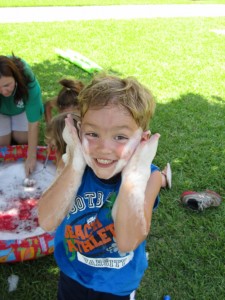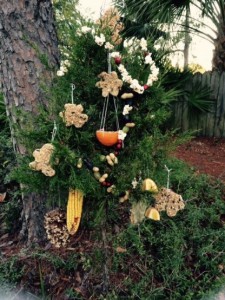by Heather Kent | Jan 30, 2015
 Chances are, if you have ever volunteered with a youth program, you have run into some children who have challenged you with their behavior. Earlier this month, Dr. Kate Fogarty and Sarah Hensley shared some insight and tips for disciplining children in a positive and productive way. The word discipline often has a negative connotation, but the origin of the word is “disciple” which means pupil, student, or apprentice. As a volunteer leader, your role is that of a guide- guiding youth towards acceptable behavior. Discipline, or guidance, is a corrective process to teach youth how to solve their problems rather than punishing them for problems they cannot solve.
Chances are, if you have ever volunteered with a youth program, you have run into some children who have challenged you with their behavior. Earlier this month, Dr. Kate Fogarty and Sarah Hensley shared some insight and tips for disciplining children in a positive and productive way. The word discipline often has a negative connotation, but the origin of the word is “disciple” which means pupil, student, or apprentice. As a volunteer leader, your role is that of a guide- guiding youth towards acceptable behavior. Discipline, or guidance, is a corrective process to teach youth how to solve their problems rather than punishing them for problems they cannot solve.
Here are three tips to remember when working with youth:
- 1. Say “Do” as an alternative to “Don’t.” Examples include:
- “Please use an inside voice during our club meeting. During recreation we will be outside and you can be loud then” instead of “Stop yelling!”
- “Can you tell me what is going on, taking turns?” instead of “Stop fighting!”
- “If you run through the woods, you could get hurt or miss seeing something really interesting” instead of “Don’t run through the woods!”
2 . Use encouragement rather than praise. Encouragement is specific and avoids comparison or competition between youth whereas praise is often vague and can foster competition. Research shows that praise can often lower self-esteem or reduce youth’s motivation for participation in an activity. Here are some examples:
| Praise |
Encouragement |
| I like your photo |
Tell me about your photo… |
| I like the way Jennifer is cleaning up |
I appreciate how Jennifer helped put the art supplies away after the meeting. It really made my job as a leader easier. |
| You did a great job on your demonstration |
How do you feel about your demonstration? |
| You clearly deserved a blue ribbon |
How do you think your record book measured up with the judging standard? |
| You have what it takes to be a great leader |
I have seen so much growth in your leadership skills, especially your ability to make good decisions and solving problems. |
- Set limits and consequences– we set limits to prevent injury to self or others and/or prevent property damage. Limits should be firm, but not strict and should be set with confidence and consistency. The key is following through with the consequences and explaining to the youth how their actions affect others. Examples:
- “If you continue to interrupt our guest speaker, you will have to find a different activity. The other members cannot hear and they want to learn about what horses eat.”
- “If you can’t remember to aim your arrow at the target, you will have to sit out for the next round of shooting. We do not want anyone to get hurt.”
- “If you cannot share, you will lose your turn because everyone wants a chance to play this game just as much as you do.”
Ultimately, the support 4-H volunteers provide youth to develop comes from a sense of safety, belonging, mastery, independence and generosity. There is a UF/IFAS Extension publication from our 4-H Volunteer Training Series on positive discipline for youth http://edis.ifas.ufl.edu/pdffiles/4H/4H34100.pdf. It provides explanations for youth misbehavior (or mistaken behavior) and non-verbal as well as verbal strategies for handling those common issues that come our way working in the field of youth development. To learn more about managing difficult behavior in a positive way, you can view the full, 1-hour workshop online at http://florida4h.org/madmondays.
by Prudence Caskey | Jan 23, 2015

How Will You Make a Difference in 2015?
Let’s all take a big, deep breath…2014 is now a thing of the past! At this moment, we all have to decide what we are going to do in 2015. What will you resolve to do in the New Year? Will you finally use your elliptical for more than just a towel rack? Will you finally finish the book you were reading or that scrapbooking project? There are no limits to what you can accomplish in 2015 and in years to come.
I work with volunteers as the Santa Rosa County 4-H Agent. I know how much time it takes to volunteer and I understand the importance of my volunteers. As a very busy wife, mother, professional, graduate student, Children’s Church director and volunteer, I am often asked how I do it all. The easy answer is prioritize. The long answer is: I make lists, lots of lists! I have shopping lists, to do lists, countdown lists and lists of when my bills are due. Lists for birthdays and anniversaries. My most important list is my goal list. I write down my daily, weekly, monthly and annual goals. I break down my larger goals into smaller goals. I am a firm believer that if we can see it, we can do it!
Whatever you decide to set as a goal for 2015, I encourage you to make a difference. We all have something to offer. At the Extension Office, I meet people every day with something to offer the youth of our county. From those who have a passion for rabbits to those who love to cook and sew. On occasion, men will not offer their expertise, because they think they may not have much to offer. Believe me, showing the young people of our community how to check the oil in their cars, rotate their tires or even build a bookcase, are great life skills to pass on to our youth.
4-H volunteers are essential to help youth make the most of a wide variety of learning experiences. As a volunteer, you can share your personal interests and expertise in a variety of subjects including gardening, shooting sports, robotics, animal science, sewing/crafting, public speaking, foods and nutrition, and much more. In 4-H, you can leverage your experience and skills to help a young person find their own passions and interests.
You decide your level of involvement to fit your schedule:
- Lead youth in a community or project club, afterschool program, camp, or school group
- Serve as a chaperone, board member, judge, or camp counselor
- Develop and support service opportunities for youth to learn caring and compassion in your community
- Work with other volunteers to create fun and exciting programs to help youth in your community reach their full potential
4-H is an opportunity we wish every young person could have because research shows it is a step forward. More than 60 million of our nation’s most successful statesmen, business leaders, and scientists credit 4-H with setting them on a positive, productive path. When you share your experiences with 4-Hers, you make a difference by helping youth become caring and competent citizens. As you make goals for 2015, consider becoming a 4-H volunteer and inspire the next generation.
by pmdavis | Jan 5, 2015

While youth are home over winter break, encourage them to do something fun that will attract wildlife. Nothing is more fun than watching birds or squirrels play in your yard. One way to make this happen is to provide a supplemental food source for them. You can create a special “Tree for Wildlife” in your yard. In fact, a great family activity is making some very inexpensive simple feeders. The most wonderful part is these feeders, they not only look attractive, but help wildlife survive through the winter.
You can create feeders out of bread, bird seed and a binding agent like eggs, lard or peanut butter. Cut stale bread into shapes with cookie cutters. Make a small hole in the top to put twine or string through. If using egg, brush the bread with egg wash and dip in seeds. Then let it dry for a day or so. Attach string and hang in the trees. If using lard or peanut butter, toast the bread to dry it out then spread like you would on a sandwich and roll in bird seed.
Another type of feeder that is popular especially if you have lots of pine trees are pine cone bird feeders. Attach string to a pine cone. Mix peanut butter and oats together then apply to pine cone. After the cone is covered with the mixture roll in bird seed. Lard can be used in place of peanut butter. Hang from tree.
One last type of feeder is using apple and orange slices. Cut thin slices of apples and oranges, attach string and hang each slice separately all around the tree.
Additional feeders could be strings of grapes, raisins, cranberries, raw peanuts, salt free crackers or popcorn. If you are using popcorn be sure it does not have butter and salt. Just use a needle and thread to make the strings. All edible decorations should be hung with biodegradable materials such as cotton string, twine, or thread.
For more information to help you invite wildlife into your yard check out Junior Master Gardener: Wildlife Gardener or Cornell Feeder Watch. Inviting wildlife into your yard provides a fun way for kids to develop a culture to care about nature, while teaching them about their environment. It also makes a great family traditional activity to do not only during the holiday season but throughout the year. 4-H is one of the nation’s most diverse organizations and includes people from all economic, racial, social, political, and geographic categories. There are no barriers to participation by any young person. Participants are given the opportunity to engage in activities that hold their personal interest, while being guided by adult volunteers. The local 4-H Agent is a youth development professional who provides direction and program leadership as part of the nationwide Cooperative Extension System. For more information, contact UF/IFAS Extension at http://florida4h.org/
.
by Heather Kent | Oct 24, 2014
 Fairs are often the highlight of the 4-H year. From a youth development perspective, fairs provide an opportunity for 4-H members to demonstrate new knowledge, abilities, skills and attitudes. When youth, parents and volunteers work together, fairs are a great way for youth to learn and also be recognized for their efforts. Being properly prepared is key to having a great fair experience.
Fairs are often the highlight of the 4-H year. From a youth development perspective, fairs provide an opportunity for 4-H members to demonstrate new knowledge, abilities, skills and attitudes. When youth, parents and volunteers work together, fairs are a great way for youth to learn and also be recognized for their efforts. Being properly prepared is key to having a great fair experience.
Youth Responsibilities- Establish a realistic timeline to work on your exhibits. Be sure to read the rules and regulations outlined in the 4-H section of the fair book. Pay close attention to deadlines and specific requirements for each project. Make sure that your exhibit is your own work. Exhibits should be in good condition, clean, and labeled with your name, county, and club. Judging score sheets for individual projects can help guide you as you prepare your exhibit.
Parent Responsibilities- Parents can help 4-H members obtain the materials and resources needed to complete 4-H projects, but should never do the project for the youth. Encourage your child to set realistic timelines and goals so that they do not miss entry deadlines. Help them complete their entry form. Many counties offer workshops or clinics in the weeks leading up to fair to help members prepare- take advantage of these sessions!
Volunteer Responsibilities- Share information about fair exhibit categories and deadlines with your 4-H parents. Project leaders are a great resource to help members decide what to exhibit about their project. It could be something they made, or it could be a poster or tabletop display about what they have learned. If possible, assign an older, more experienced member to mentor new members as they prepare.
Consider having a mock judging of exhibits so that any last minute adjustments can be made. Invite parents to attend along with the members and use this meeting as an opportunity to provide feedback and recognition to individual members and to promote club unity and pride.
4-H members are encouraged to try something more challenging each year and to practice good sportsmanship. Exhibiting is designed to be an enjoyable educational experience not just a contest. If you would like to help 4-Hers in your county get ready for the fair, or serve as a judge for your fair, contact your local county Extension Office.
by Heather Kent | Oct 3, 2014
 4-H Meetings should be fun for both the members and the volunteers. Club environments that cultivate belonging, mastery, independence, and generosity. Leading a 4-H club should be a fun and rewarding experience. Earlier this month, during our Make a Difference Monday Volunteer Leader Series, Tycee Prevatt shared some simple, but creative ideas to make club meetings fun, but also more manageable!
4-H Meetings should be fun for both the members and the volunteers. Club environments that cultivate belonging, mastery, independence, and generosity. Leading a 4-H club should be a fun and rewarding experience. Earlier this month, during our Make a Difference Monday Volunteer Leader Series, Tycee Prevatt shared some simple, but creative ideas to make club meetings fun, but also more manageable!
Divide your club into teams of 3-5 youth. Assign an older 4-Her (intermediate or teen) to serve as the team leader. This will not only make your club more manageable, but it also fosters leadership, teamwork, and cooperation- three essential skills for a happy and productive life.
How this works:
- Assign each team a color (buy inexpensive plastic tablecloths at the dollar store in each team color).
- Teams sit together during club meetings/functions. Parents sit behind the teams so as not to interfere.
- Teams can earn points for: attendance, being prepared for club meetings, being on time, doing a club demonstration, participating in a club service project, and attending 4-H events and activities beyond the club level (such as a day camp or canning workshop).
- As the leader, you can also use “pop quizzes” or project skill a thons to allow more opportunities to collect points. Parent can help with the skill a thon stations and your 4-H agent can help you set up a skill a thon. Stations can be project specific, such as naming the parts of a saddle, or they can be more general, such as reciting the 4-H pledge from memory or answering 4-H trivia questions.
It is important to set up a points system before introducing this to the club. This idea is really easy to adapt to any club situation. This example of a club points system is from a livestock club.
You will also need to decide on appropriate incentives. Some clubs give out a grand prize to the top team, others give prizes for 1st, 2nd, and 3rd teams. Ideas include: partial scholarships to 4-H camp, cash award, pizza or bowling party, or a fun field trip related to their project. Your club may need to do some fundraising to help pay for the prizes.
The team approach works well because it really encourages the members to attend the meetings on time and prepared. It helps motivate them to become more engaged. You will also have fewer interruptions or discipline issues, because teams can lose points for that! This approach works particularly well for medium to large clubs and can even be adapted for use during camp.
What are your best tips for making meetings fun? Let us know in the comment box below. Also, make plans to join us on October 20th for Make a Difference Monday at 7/6 central. Dr. Dale Pracht will be sharing how to create safe environments in our 4-H clubs. If you cannot make our live presentation, it will be archived along with this month’s presentation at http://florida4h.org/madmondays.
by Heather Kent | Aug 29, 2014
It’s that time of year again- time to re-enroll in 4-H! All volunteer and member profiles were set to inactive on August 23rd, so in order to be a member or volunteer this year you will need to re-enroll. The online enrollment system that we use is called Florida 4-H Online and can be accessed at http://florida.4honline.com . To re-enroll, you will need access to a computer and the internet. If you do not have access at home, you can visit your local library or Extension office. Many offices will have a kiosk set up in their lobby this time of year so that volunteers and members can quickly stop by and complete the re-enrollment process.
If you were a volunteer or member last year, you will just need to update your profile. If you forgot your family login, contact your extension office and they can re-set it for you. Be sure to enter any changes to your contact information or health form. Members will also need to select a club and project for the year. If you are a volunteer, and it has been at least 5 years since you were screened, you will be asked to complete the application and screening process again. The level of screening will be determined by your level of involvement as a volunteer. Your local extension office will notify you if you need to complete a new application and screening.
If you are new to 4-H this year (or to our state), then you will need to create a new family profile, and then a profile for each family member old enough to participate in 4-H. Your first time enrolling will take a little longer, but each year after that the process is not as involved.
Club leaders may want to work with their local 4-H agent to set up a club kickoff meeting and arrange to have an enrollment kiosk set up so that parents can enroll or re-enroll their children when they drop off/pick up children from the club meeting. For step by step instructions on how to re-enroll, visit: http://florida4h.org/4honline/files/Instructions-for-4-H-Online-Enrollment.pdf. Your local extension office is also happy to help you if you have any questions. Many fall fairs, as well as state events have enrollment requirements within so many days of the event, so do not wait to re-enroll!
 Chances are, if you have ever volunteered with a youth program, you have run into some children who have challenged you with their behavior. Earlier this month, Dr. Kate Fogarty and Sarah Hensley shared some insight and tips for disciplining children in a positive and productive way. The word discipline often has a negative connotation, but the origin of the word is “disciple” which means pupil, student, or apprentice. As a volunteer leader, your role is that of a guide- guiding youth towards acceptable behavior. Discipline, or guidance, is a corrective process to teach youth how to solve their problems rather than punishing them for problems they cannot solve.
Chances are, if you have ever volunteered with a youth program, you have run into some children who have challenged you with their behavior. Earlier this month, Dr. Kate Fogarty and Sarah Hensley shared some insight and tips for disciplining children in a positive and productive way. The word discipline often has a negative connotation, but the origin of the word is “disciple” which means pupil, student, or apprentice. As a volunteer leader, your role is that of a guide- guiding youth towards acceptable behavior. Discipline, or guidance, is a corrective process to teach youth how to solve their problems rather than punishing them for problems they cannot solve.



